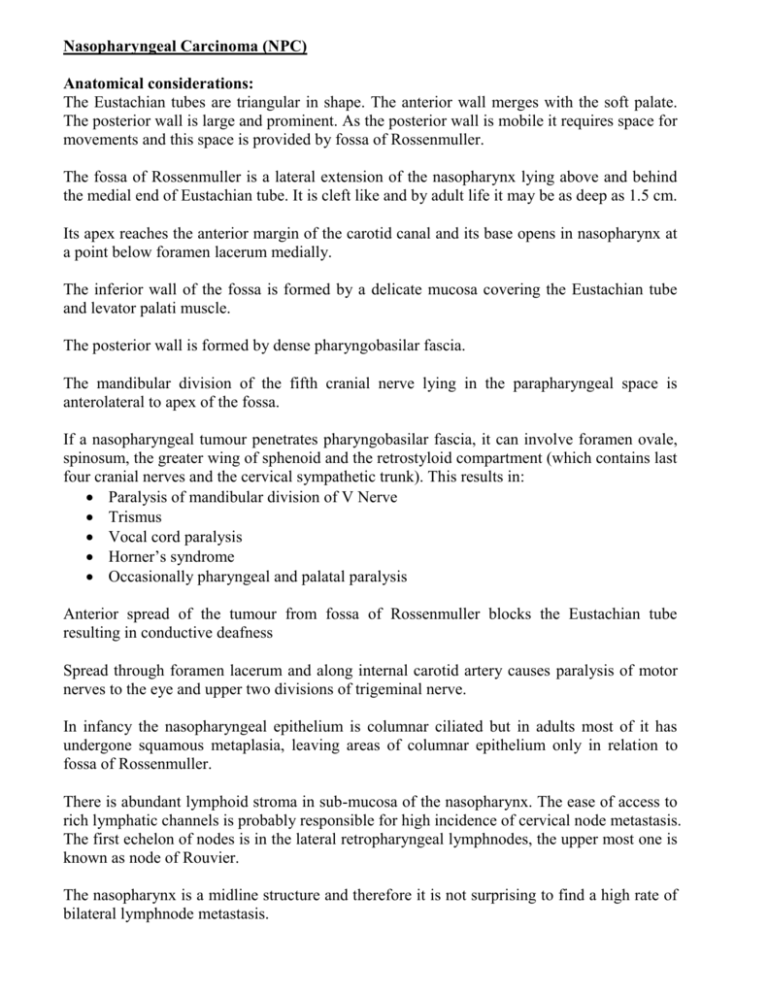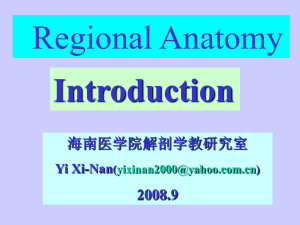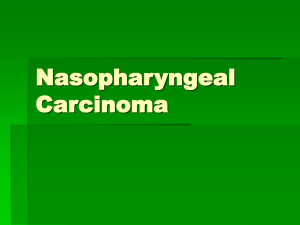Nasopharyngeal Carcinoma
advertisement

Nasopharyngeal Carcinoma (NPC) Anatomical considerations: The Eustachian tubes are triangular in shape. The anterior wall merges with the soft palate. The posterior wall is large and prominent. As the posterior wall is mobile it requires space for movements and this space is provided by fossa of Rossenmuller. The fossa of Rossenmuller is a lateral extension of the nasopharynx lying above and behind the medial end of Eustachian tube. It is cleft like and by adult life it may be as deep as 1.5 cm. Its apex reaches the anterior margin of the carotid canal and its base opens in nasopharynx at a point below foramen lacerum medially. The inferior wall of the fossa is formed by a delicate mucosa covering the Eustachian tube and levator palati muscle. The posterior wall is formed by dense pharyngobasilar fascia. The mandibular division of the fifth cranial nerve lying in the parapharyngeal space is anterolateral to apex of the fossa. If a nasopharyngeal tumour penetrates pharyngobasilar fascia, it can involve foramen ovale, spinosum, the greater wing of sphenoid and the retrostyloid compartment (which contains last four cranial nerves and the cervical sympathetic trunk). This results in: Paralysis of mandibular division of V Nerve Trismus Vocal cord paralysis Horner’s syndrome Occasionally pharyngeal and palatal paralysis Anterior spread of the tumour from fossa of Rossenmuller blocks the Eustachian tube resulting in conductive deafness Spread through foramen lacerum and along internal carotid artery causes paralysis of motor nerves to the eye and upper two divisions of trigeminal nerve. In infancy the nasopharyngeal epithelium is columnar ciliated but in adults most of it has undergone squamous metaplasia, leaving areas of columnar epithelium only in relation to fossa of Rossenmuller. There is abundant lymphoid stroma in sub-mucosa of the nasopharynx. The ease of access to rich lymphatic channels is probably responsible for high incidence of cervical node metastasis. The first echelon of nodes is in the lateral retropharyngeal lymphnodes, the upper most one is known as node of Rouvier. The nasopharynx is a midline structure and therefore it is not surprising to find a high rate of bilateral lymphnode metastasis. Epidemiology: The NPC accounts for 18% of all malignant neoplasms in Cantonese. In Europe it accounts for 6% of all malignant neoplasms of head and neck. In Singapore it is the second most common tumour. Aetiology: The aetiology of the NPC has been well explained. The three important factors are: The Epstein-Barr virus- which acts as a carcinogen. Although NPC is an epithelial tumour which occurs many years after peak incidence of EBV infection, the lesion appears related to viral capsid antigen, early antigen and nuclear antigen. Only the undifferentiated or poorly differentiated forms of NPC are associated with EBV. A genetically determined susceptibility in Cantonese. Genetic factors play an important role aetiology of NPC that is suggested by high incidence of tumour in southern Chinese population.. An environmental factor which is thought to be eating of salted preserved fish and a deficiency of Vitamin C in southern Chinese people. Chinese salted fish contains volatile nitrosamines which are potent carcinogenics. In the Chinese the highest incidence is in fourth decade of life while in non-Chinese it is in sixth decade of life. The male female ratio is 3:1 in Chinese and 2:1 in non-Chinese. Tumour types SCC carcinoma constitutes 85% of all malignant tumours of NPC. It is divided into three types as per WHO classification. These all are varieties of SCC/ Keratinizing SCC, which may be well, moderately or poorly differentiated. Non-keratinizing poorly differentiated Undifferentiated carcinoma of nasopharynx. Site of origin While most classification systems attempt to categorize NPC into those arising from vault and those arising from lateral walls, it is impossible to tell from where the tumour is arising. It is thought that most arise from fossa of Rossenmuller but many will present with metastatic nodes even before declaring themselves in nasopharynx. Almost half the patients will have metastatic nodes. About one in three will have unilateral and one in five will have bilateral nodes. Tumour spreads by direct infiltration into basiocciput and middle cranial fossa paralyzing all the cranial nerves from third to twelfth. The second most common adult tumour is lymphoma and in 95% of cases it is non Hodgkin lymphoma. Other types are Adenocarcinoma, adenoidcystic carcinoma and malignant melanoma. In children rhabdomyosarcoma is most commonly encountered maliganancy and accounts for 30% of all malignancies in this site in children. History Common presenting symptoms of NPC are: Nasal Obstruction Cervical lymphadenopathy Conductive deafness Cranial nerve palsies. The combination of conductive deafness, elevation and immobility of homolateral soft palate together with pain in the side of neck (due to fifth cranial nerve involvement) represent symptoms of local invasion and is called Trotter’s triad. The remainder present with headache, diplopia, facial numbness, hypoaesthesia, trismus, ptosis and hoarseness. A Caucasian over the age of 40 years c/o unilateral conductive deafness or with an enlarged lymphnode should be regarded with high degree of suspicion. Clinical Examination: Post nasal examination must be regarded as inadequate. Endoscopic examination of nose and nasopharynx: exophytic lesions are easily seen Examine palate for any downwards push effect of the tumour and or paralysis Ears are examined for retraction of tympanic membrane or fluid behind the ear Look for trismus which indicates involvement of para-pharyngeal space Palpate neck for any lymph node metastasis Enlarged Rouvier’s lymph node may be seen in posterior pharyngeal wall In children below 12 years of age, a mass in the nasopharynx may be a rhabydomyosarcoma Laboratory Studies: Blood for Haemoglobin and ESR- A raised ESR may be due tolymphoma Audiometery: PTA for determining conductive deafness and impedance for Eustachian tube function Imaging: CT scan to look for any destruction of pterygoid plates, formen lacerum, spinosum, ovale and jugular. Tumour extension into sphenoid or ethmoid sinuses. MRI for delineation of tumour margins, vascularity of the Tx nd intracranial extension Distant metastatsis is looked for CXR, skeletal scintigraphy and abdominal ultrasound study. Biopsy should be considered under GA Staging of Tumour: 1. Tx: Primary tumour can not be assessed 2. To: No evidence of primary Tumour 3. Tis: Carcinoma-in-situ 4. T1: Tumour confined to nasopharynx 5. T2: Tumour extension to oropharynx or nasal fossa a. T2a: Without PPS extension b. T2b: With PPS extension 6. T3: Invasion of the bone 7. T4: Intracranial extension, involvement of cranial nerves, infra temporal fossa, hypopharynx, orbit o N1: Unilateral LN involvement o N2: Bilateral, < 6cm in size o N3: > 6 cm in size Staging: o I: Tumour confined to NP o II: Tumour with extension to oropharynx or nasal fossa o III: Extension to sphenoid,PPS, IFT fossa, o IV: I/C extension Treatment; o Most of the patients are treated radically o Patients with distant metastasis at the time of presentation are treated with palliative measures and symptomatic tumours o Radiotherapy: o It is primary treatment modality for NPC o Large fields are used o Patients with neck node involvement need neck irradiation o 40 Gy units over 20 fractions and 26 Gy in 13 fractions o Chemotherapy is being used in conjuction with radiotherapy (platinum based combinations are used) o 3 year survival rate with RT alone is 46% o 3 year survival rate with RT and Chemo together iis 76% o Surgery has no role in treatment of NPC Side effects of RT include anorexia, fatigue, mucositis, persistent xerostomia, trismus and ocular complications Side effects of Chemo include myelosuppression, ototoxicity and renal damage.







